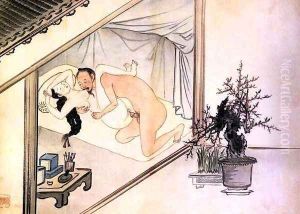Hongdo Gim Paintings
Hongdo Gim, also known as Kim Hong-do, is one of the most celebrated painters in Korean history. Born in 1745 in the province of Ansan in Gyeonggi-do, he is also often referred to by his pen name, Danwon. His exact date of death is somewhat uncertain, but he is believed to have died around 1806.
Kim Hong-do demonstrated artistic talent from a very young age and was taken to the capital, Hanyang (present-day Seoul), to study painting. He was a part of the Dohwaseo, the official painting bureau of the Joseon Dynasty, and eventually became a court painter. His work as a court painter involved creating works for the royal family and the aristocracy, which provided him with a breadth of subject matter and the opportunity to hone his skills in various painting styles.
Hongdo's artistry covered a wide range of subjects, from landscapes and portraits to genre paintings depicting the daily lives of common people. He was particularly renowned for his genre paintings, which are considered some of the most valuable for their detailed observation of the daily life during the Joseon dynasty. His depictions of farmers, merchants, and entertainers are lively and full of character, often imbued with a sense of humor and satire.
Kim Hong-do's style was influenced by both traditional Korean painting and the techniques imported from Ming and Qing Dynasty China. However, he is credited with developing a distinctly Korean approach to painting, characterized by clear lines, bright colors, and a sense of realism. His ability to capture the essence of his subjects with a few deft strokes of the brush was particularly admired.
Throughout his life, Kim Hong-do trained many students, helping to spread his artistic techniques and contributing to the development of a uniquely Korean style of painting. His legacy is such that his work is still studied and revered in South Korea, where he is considered a national treasure. His paintings are preserved in several museums in South Korea and have been declared national treasures.
Kim Hong-do’s life and work are celebrated in South Korea to this day, and his influence on Korean art is considered equivalent to that of artists like Goya or Rembrandt in the West. His dedication to capturing the spirit of Korea and its people in his art has left a lasting impression on the cultural heritage of his country.
